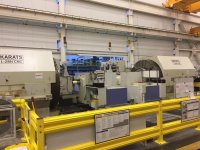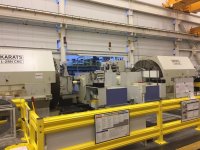Having problems with arc traces being left on the contact faces. Machine has been grounded on both head stocks with extra ground straps through the belt. Machine is Karats L28N with twin 2800mm chucks. I have tested for voltage through the chuck and find none but do show a open line dropping in and out when spinning the chuck. Anyone had these issues before?
How to install the app on iOS
Follow along with the video below to see how to install our site as a web app on your home screen.
Note: This feature may not be available in some browsers.
You are using an out of date browser. It may not display this or other websites correctly.
You should upgrade or use an alternative browser.
You should upgrade or use an alternative browser.
Arc Traces On Lathe Chuck.
- Thread starter Jason L
- Start date
- Replies 24
- Views 3,456
michiganbuck
Diamond
- Joined
- Jun 28, 2012
- Location
- Mt Clemens, Michigan 48035
We had a vendor selling an electrical device that he said would determine the voltage created by a machining operation and build an opposing force to make zero energy transfer so saving tool life...we did not try it..perhaps too expensive ..I don't remember why we did not try it..
Vancbiker
Diamond
- Joined
- Jan 5, 2014
- Location
- Vancouver, WA. USA
A lathe with twin 9 foot chucks? Is that a main and sub-spindle configuration? Post a picture. I tried to google "Karats L28N" but got nothing.
triumph406
Diamond
- Joined
- Sep 14, 2008
- Location
- ca
Hopefully it's not finding a path thru the bearings.
gregormarwick
Diamond
- Joined
- Feb 7, 2007
- Location
- Aberdeen, UK
A lathe with twin 9 foot chucks? Is that a main and sub-spindle configuration? Post a picture. I tried to google "Karats L28N" but got nothing.
I'm assuming oil country lathe - big hollow spindle with a second chuck on the rear of the spindle. I have vague idea that Karats is a manufacturer of those...
cwtoyota
Cast Iron
- Joined
- Feb 11, 2010
- Location
- Washington State
We had a vendor selling an electrical device that he said would determine the voltage created by a machining operation and build an opposing force to make zero energy transfer so saving tool life...we did not try it..perhaps too expensive ..I don't remember why we did not try it..
That's interesting, they do something like that in the marine industry: "active corrosion protection" or "cathodic protection" are some names used.
The shipboard device attempts to change voltages between ship and water and thus prevent or eliminate corrosion.
Vancbiker
Diamond
- Joined
- Jan 5, 2014
- Location
- Vancouver, WA. USA
I'm assuming oil country lathe - big hollow spindle with a second chuck on the rear of the spindle.
Well, he said "on both head stocks". That's what I was curious about. Doesn't sound like the typical oil country lathe with 2 chucks on the same headstock.
Karats Lathe

The lathe is used to manufacture rotor disc components for Gas Turbine.
here are the arc paths I am seeing. It is actually in multiple locations but this is good example.
Well, he said "on both head stocks". That's what I was curious about. Doesn't sound like the typical oil country lathe with 2 chucks on the same headstock.

The lathe is used to manufacture rotor disc components for Gas Turbine.
here are the arc paths I am seeing. It is actually in multiple locations but this is good example.

HuFlungDung
Diamond
- Joined
- Jan 19, 2005
- Location
- Canada
I've never heard of this issue before, it's hard for me to believe you'd get enough static buildup from machining to do that.
Some large electric motors have one insulated bearing seat on the rotor shaft, I guess to help stop some kind of eddy (?) current flow down the shaft. Any chance such a thing would be needed here?
Some large electric motors have one insulated bearing seat on the rotor shaft, I guess to help stop some kind of eddy (?) current flow down the shaft. Any chance such a thing would be needed here?
Mebfab
Diamond
- Joined
- Jun 7, 2003
- Location
- Mebane North Carolina USA
The 2 spots in pic, are those weld repairs?
Ox
Diamond
- Joined
- Aug 27, 2002
- Location
- Northwest Ohio
The 2 spots in pic, are those weld repairs?
Or lacking tool clearance?
Does this heifer have live toys and a Y?
If so, I may hafta put that on my list for next Christmas!
------------------------
Think Snow Eh!
Ox
B-Mathews
Hot Rolled
- Joined
- Sep 20, 2013
- Location
- Beaverton Oregon
It sure looks like tools have hit the chuck and two blue spots look like welded repairs.
What a lathe though.
What a lathe though.
Vancbiker
Diamond
- Joined
- Jan 5, 2014
- Location
- Vancouver, WA. USA
.....do show a open line dropping in and out when spinning the chuck.
Can you explain this better?
Do you have an electrical engineer available to consult on this?
Monarchist
Diamond
- Joined
- Oct 2, 2012
- Location
- Sol, Terra
Sorry new to this forum thing. Thought id reach out of my box a little and dig for some knowledge. View attachment 218550View attachment 218551
You ARE in the size range that serious electricity can be generated, yes. Several here can grok that.
Simply filling a tank of gasoline - a dielectric, as your coolant may also be - generates more than enough static charge from the turbulence in the flow to cause a fire if not carefully grounded. Van de Graff generators were often small, but impressive, nonetheless. Friction, once again.
Our observations and opinions, here, won't be much help.
You need to get a specialist on-site to measure, calculate, actually do something useful ABOUT it, measure again to confirm a(ny) solution is actually effective.
Former General Electric now not Glyptal brewers have a conductive paint to bleed-off that sort of induced static. Costly stuff. It has to stand high heats of motor housings that the cheap carpet spray for a 'puter desk never sees. You'll need that specialist to know if it is part of the solution.
The damage you can SEE may be only a part of it. Company may not have planned to do welding on this lathe. Bearings may not have gotten that memo.
gregormarwick
Diamond
- Joined
- Feb 7, 2007
- Location
- Aberdeen, UK
What are we actually looking at in the right picture? Is that a fixture plate that the part gets flat mounted on?
Is there any possibility that is mechanical fretting rather than arcing? The two can appear very similar visually...
Is there any possibility that is mechanical fretting rather than arcing? The two can appear very similar visually...
Ox
Diamond
- Joined
- Aug 27, 2002
- Location
- Northwest Ohio
Couldn't you just put a copper strip on the back of the chuck?
---------------
Think Snow Eh!
Ox
---------------
Think Snow Eh!
Ox
Can you explain this better?
Do you have an electrical engineer available to consult on this?
I am seeing a open line with meter when spinning the chuck and testing no voltage though. What I am attempting to do now is a brass strap on the spacer at 200 rpm from the tool post and running against spacer. And we do absolutely no welding on our machines. The parts are forbidden to be welded on for new manufactured components.
alphonso
Titanium
- Joined
- Feb 15, 2006
- Location
- Republic of Texas
Having problems with arc traces being left on the contact faces.
Contact faces of what? Chuck? Work piece? Where cutting tool touches work?
Machine has been grounded on both head stocks with extra ground straps through the belt.
Belt? What belt? How do you ground a belt?
I have tested for voltage through the chuck and find none but do show a open line dropping in and out when spinning the chuck. Anyone had these issues before?
Voltage thru chuck to where? Open line where? Incoming lines to control? Lines from control to motor(s)?
Monarchist
Diamond
- Joined
- Oct 2, 2012
- Location
- Sol, Terra
Couldn't you just put a copper strip on the back of the chuck?
Both ends, probably.
Just to name one of several, Helwig Carbon - the brush makers - have a whole product line for grounding shafts where VFD or DC Drive are doing the dirty to bearings.
They also make custom fits, so shape and size of Fat Albert here should not be an issue.
The First Name in Carbon Brush Technology - Helwig Carbon
Similar threads
- Replies
- 30
- Views
- 1K
- Replies
- 3
- Views
- 161
- Replies
- 29
- Views
- 1K



